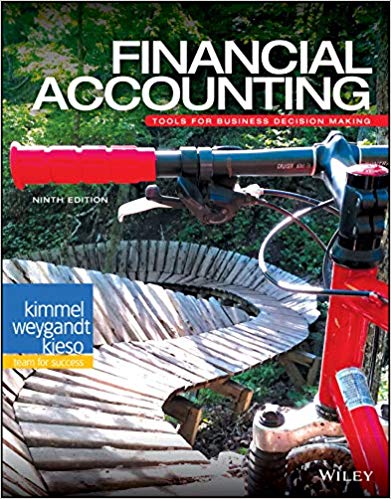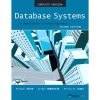Test Bank for Financial Accounting Tools for Business Decision Making 9th by Kimmel
$35.00 Original price was: $35.00.$26.50Current price is: $26.50.
Test Bank for Financial Accounting Tools for Business Decision Making 9th by Kimmel
Instant download Test Bank for Financial Accounting Tools for Business Decision Making 9th by Kimmel pdf docx epub after payment.

Product details:
- ISBN-10 : 1119493633
- ISBN-13 : 978-1119493631
- Author: Paul D. Kimmel (Author), Jerry J. Weygandt (Author), Donald E. Kieso (Author)
Financial Accounting: Tools for Business Decision Making, Ninth Edition, provides a simple and practical introduction to financial accounting. It explains the concepts students need to know, while also emphasizing the importance of decision making. In this new edition, all content has been carefully reviewed and revised to ensure maximum student understanding. At the same time, the time-tested features that have proven to be of most help to students such the student-friendly writing style, visual pedagogy, and the relevant and easy-to-understand examples have been retained.
Table of contents:
1 Introduction to Financial Statements 1-1
Knowing the Numbers: Columbia Sportswear Company 1-1
Business Organization and Accounting Information Uses 1-2
Forms of Business Organization 1-3
Users and Uses of Financial Information 1-3
Ethics in Financial Reporting 1-5
The Three Types of Business Activity 1-7
Financing Activities 1-7
Investing Activities 1-8
Operating Activities 1-8
The Four Financial Statements 1-9
Income Statement 1-10
Retained Earnings Statement 1-11
Balance Sheet 1-11
Statement of Cash Flows 1-12
Interrelationships of Statements 1-13
Other Elements of an Annual Report 1-16
A Look at IFRS 1-42
2 A Further Look at Financial Statements 2-1
Just Fooling Around?: The Motley Fool 2-2
The Classified Balance Sheet 2-3
Current Assets 2-3
Long-Term Investments 2-5
Property, Plant, and Equipment 2-5
Intangible Assets 2-5
Current Liabilities 2-7
Long-Term Liabilities 2-7
Stockholders’ Equity 2-7
Analyzing the Financial Statements Using Ratios 2-8
Ratio Analysis 2-8
Using the Income Statement 2-9
Using a Classified Balance Sheet 2-10
Using the Statement of Cash Flows 2-13
Financial Reporting Concepts 2-15
The Standard-Setting Environment 2-16
Qualities of Useful Information 2-16
Assumptions in Financial Reporting 2-17
Principles in Financial Reporting 2-18
Cost Constraint 2-19
A Look at IFRS 2-45
3 The Accounting Information System 3-1
Accidents Happen: MF Global Holdings Ltd 3-1
Using the Accounting Equation to Analyze Transactions 3-3
Accounting Transactions 3-3
Analyzing Transactions 3-4
Summary of Transactions 3-10
Accounts, Debits, and Credits 3-11
Debits and Credits 3-11
Debit and Credit Procedures 3-12
Stockholders’ Equity Relationships 3-15
Summary of Debit/Credit Rules 3-16
Using a Journal 3-17
The Recording Process 3-17
The Journal 3-18
The Ledger and Posting 3-20
The Ledger 3-20
Chart of Accounts 3-20
Posting 3-21
The Recording Process Illustrated 3-22
Summary Illustration of Journalizing and Posting 3-28
The Trial Balance 3-30
Limitations of a Trial Balance 3-31
A Look at IFRS 3-61
4 Accrual Accounting Concepts 4-1
Keeping Track of Groupons: Groupon 4-1
Accrual-Basis Accounting and Adjusting Entries 4-2
The Revenue Recognition Principle 4-3
The Expense Recognition Principle 4-4
Accrual versus Cash Basis of Accounting 4-5
The Need for Adjusting Entries 4-5
Types of Adjusting Entries 4-6
Adjusting Entries for Deferrals 4-7
Prepaid Expenses 4-7
Unearned Revenues 4-11
Adjusting Entries for Accruals 4-14
Accrued Revenues 4-14
Accrued Expenses 4-16
Summary of Basic Relationships 4-19
The Adjusted Trial Balance and Closing Entries 4-21
Preparing the Adjusted Trial Balance 4-21
Preparing Financial Statements 4-22
Quality of Earnings 4-23
Closing the Books 4-26
Summary of the Accounting Cycle 4-28
Appendix 4A: Using a Worksheet 4-33
A Look at IFRS 4-65
5 Merchandising Operations and the Multiple-Step Income Statement 5-1
Buy Now, Vote Later: REI 5-1
Merchandising Operations and Inventory Systems 5-3
Operating Cycles 5-3
Flow of Costs 5-4
Recording Purchases Under a Perpetual System 5-6
Freight Costs 5-8
Purchase Returns and Allowances 5-9
Purchase Discounts 5-9
Summary of Purchasing Transactions 5-10
Recording Sales Under a Perpetual System 5-11
Sales Returns and Allowances 5-12
Sales Discounts 5-13
Data Analytics and Credit Sales 5-14
Multiple-Step and Comprehensive Income Statements 5-15
Single-Step Income Statement 5-15
Multiple-Step Income Statement 5-16
Comprehensive Income Statement 5-19
Cost of Goods Sold Under a Periodic System 5-21
Gross Profit Rate and Profit Margin 5-22
Gross Profit Rate 5-22
Profit Margin 5-23
Appendix 5A: Periodic Inventory System 5-26
Recording Merchandise Transactions 5-26
Recording Purchases of Merchandise 5-27
Freight Costs 5-27
Recording Sales of Merchandise 5-27
Comparison of Entries—Perpetual vs. Periodic 5-28
Appendix 5B: Adjusting Entries for Credit Sales with Returns and Allowances 5-29
A Look at IFRS 5-54
6 Reporting and Analyzing Inventory 6-1
“Where Is That Spare Bulldozer Blade?”: Caterpillar 6-1
Classifying and Determining Inventory 6-2
Classifying Inventory 6-2
Determining Inventory Quantities 6-4
Inventory Methods and Financial Effects 6-6
Specific Identification 6-7
Cost Flow Assumptions 6-7
Financial Statement and Tax Eff ects of Cost Flow Methods 6-12
Using Inventory Cost Flow Methods Consistently 6-14
Inventory Presentation and Analysis 6-15
Presentation 6-15
Lower-of-Cost-or-Net Realizable Value 6-16
Analysis 6-16
Adjustments for LIFO Reserve 6-18
Appendix 6A: Inventory Cost Flow Methods in Perpetual Inventory Systems 6-21
First-In, First-Out (FIFO) 6-22
Last-In, First-Out (LIFO) 6-22
Average-Cost 6-23
Appendix 6B: Eff ects of Inventory Errors 6-23
Income Statement Eff ects 6-24
Balance Sheet Eff ects 6-25
A Look at IFRS 6-48
7 Fraud, Internal Control, and Cash 7-1
Minding the Money in Madison: Barriques 7-1
Fraud and Internal Control 7-3
Fraud 7-3
The Sarbanes-Oxley Act 7-3
Internal Control 7-4
Principles of Internal Control Activities 7-4
Data Analytics and Internal Controls 7-10
Limitations of Internal Control 7-11
Cash Controls 7-12
Cash Receipts Controls 7-12
Cash Disbursements Controls 7-14
Petty Cash Fund 7-16
Control Features of a Bank Account 7-17
Electronic Funds Transfer (EFT) System 7-17
Bank Statements 7-18
Reconciling the Bank Account 7-19
Reporting Cash and Cash Management 7-24
Reporting Cash 7-24
Managing and Monitoring Cash 7-25
Cash Budgeting 7-27
Appendix 7A: Operation of a Petty Cash Fund 7-30
Establishing the Petty Cash Fund 7-30
Making Payments from the Petty Cash Fund 7-31
Replenishing the Petty Cash Fund 7-31
A Look at IFRS 7-56
8 Reporting and Analyzing Receivables 8-1
What’s Cooking? Nike 8-1
Recognition of Accounts Receivable 8-3
Types of Receivables 8-3
Recognizing Accounts Receivable 8-3
Valuation and Disposition of Accounts Receivable 8-5
Valuing Accounts Receivable 8-5
Disposing of Accounts Receivable 8-12
Notes Receivable 8-14
Determining the Maturity Date 8-15
Computing Interest 8-15
Recognizing Notes Receivable 8-16
Valuing Notes Receivable 8-16
Disposing of Notes Receivable 8-16
Receivables Presentation and Management 8-18
Financial Statement Presentation of Receivables 8-19
Managing Receivables 8-19
Evaluating Liquidity of Receivables 8-21
Accelerating Cash Receipts 8-23
Data Analytics and Receivables Management 8-24
A Look at IFRS 8-47
9 Reporting and Analyzing Long-Lived Assets 9-1
A Tale of Two Airlines: American Airlines 9-1
Plant Asset Expenditures 9-3
Determining the Cost of Plant Assets 9-3
Expenditures During Useful Life 9-6
To Buy or Lease? 9-7
Depreciation Methods 9-8
Factors in Computing Depreciation 9-8
Depreciation Methods 9-9
Revising Periodic Depreciation 9-13
Impairments 9-14
Plant Asset Disposals 9-15
Sale of Plant Assets 9-16
Retirement of Plant Assets 9-17
Intangible Assets 9-18
Accounting for Intangible Assets 9-18
Types of Intangible Assets 9-19
Statement Presentation and Analysis 9-21
Presentation 9-21
Analysis 9-23
Appendix 9A: Other Depreciation Methods 9-27
Declining-Balance Method 9-27
Units-of-Activity Method 9-28
A Look at IFRS 9-54
10 Reporting and Analyzing Liabilities 10-1
And Then There Were Two: Maxwell Car Company 10-1
Accounting for Current Liabilities 10-3
What Is a Current Liability? 10-3
Notes Payable 10-3
Sales Taxes Payable 10-4
Unearned Revenues 10-5
Current Maturities of Long-Term Debt 10-5
Payroll and Payroll Taxes Payable 10-6
Major Characteristics of Bonds 10-8
Types of Bonds 10-8
Issuing Procedures 10-9
Bond Trading 10-9
Determining the Market Price of a Bond 10-10
Accounting for Bond Transactions 10-12
Issuing Bonds at Face Value 10-13
Discount or Premium on Bonds 10-13
Issuing Bonds at a Discount 10-14
Issuing Bonds at a Premium 10-15
Redeeming Bonds at Maturity 10-17
Redeeming Bonds Before Maturity 10-17
Presentation and Analysis 10-18
Presentation 10-18
Analysis 10-20
Appendix 10A: Straight-Line Amortization 10-24
Amortizing Bond Discount 10-24
Amortizing Bond Premium 10-26
Appendix 10B: Effective-Interest Amortization 10-27
Amortizing Bond Discount 10-27
Amortizing Bond Premium 10-29
Appendix 10C: Accounting for Long-Term
Notes Payable 10-30
A Look at IFRS 10-58
11 Reporting and Analyzing Stockholders’ Equity 11-1
Oh Well, I Guess I’ll Get Rich: Facebook 11-1
Corporate Form of Organization 11-3
Characteristics of a Corporation 11-3
Forming a Corporation 11-6
Stockholder Rights 11-6
Stock Issue Considerations 11-7
Corporate Capital 11-9
Accounting for Common, Preferred, and Treasury Stock 11-11
Accounting for Common Stock 11-11
Accounting for Preferred Stock 11-12
Accounting for Treasury Stock 11-13
Cash Dividends, Stock Dividends, and Stock Splits 11-15
Cash Dividends 11-15
Dividend Preferences 11-17
Stock Dividends 11-19
Stock Splits 11-20
Presentation and Analysis 11-22
Retained Earnings 11-22
Retained Earnings Restrictions 11-23
Balance Sheet Presentation of Stockholders’ Equity 11-24
Analysis of Stockholders’ Equity 11-26
Debt Versus Equity Decision 11-27
Appendix 11A: Entries for Stock Dividends 11-30
A Look at IFRS 11-54
12 Statement of Cash Flows 12-1
Got Cash?: Microsoft 12-1
Usefulness and Format of the Statement of Cash Flows 12-3
Usefulness of the Statement of Cash Flows 12-3
Classification of Cash Flows 12-3
Significant Noncash Activities 12-4
Format of the Statement of Cash Flows 12-5
Preparing the Statement of Cash Flows— Indirect Method 12-6
Indirect and Direct Methods 12-7
Indirect Method—Computer Services Company 12-7
Step 1: Operating Activities 12-9
Summary of Conversion to Net Cash Provided by Operating Activities—Indirect Method 12-12
Step 2: Investing and Financing Activities 12-13
Step 3: Net Change in Cash 12-14
Analyzing the Statement of Cash Flows 12-17
The Corporate Life Cycle 12-17
Free Cash Flow 12-19
Appendix 12A: Statement of Cash Flows—Direct Method 12-22
Step 1: Operating Activities 12-23
Step 2: Investing and Financing Activities 12-28
Step 3: Net Change in Cash 12-29
Appendix 12B: Worksheet for the Indirect Method 12-29
Preparing the Worksheet 12-30
Appendix 12C: Statement of Cash Flows—T-Account Approach 12-34
A Look at IFRS 12-61
13 Financial Analysis: The Big Picture 13-1
It Pays to Be Patient: Warren Buffett 13-2
Sustainable Income and Quality of Earnings 13-3
Sustainable Income 13-3
Quality of Earnings 13-7
Horizontal Analysis and Vertical Analysis 13-9
Horizontal Analysis 13-10
Vertical Analysis 13-12
Ratio Analysis 13-14
Liquidity Ratios 13-15
Solvency Ratios 13-16
Profitability Ratios 13-16
Financial Analysis and Data Analytics 13-17
Comprehensive Example of Ratio Analysis 13-17
A Look at IFRS 13-54
APPENDIX A Specimen Financial Statements: Apple Inc. A-1
APPENDIX B Specimen Financial Statements: Columbia Sportswear Company B-1
APPENDIX C Specimen Financial Statements: VF Corporation C-1
APPENDIX D Specimen Financial Statements: Amazon.com, Inc. D-1
APPENDIX E Specimen Financial Statements: Wal-Mart Stores, Inc. E-1
APPENDIX F Specimen Financial Statements: Louis Vuitton F-1
APPENDIX G Time Value of Money G-1
Interest and Future Values G-1
Nature of Interest G-1
Future Value of a Single Amount G-3
Future Value of an Annuity G-5
Present Values G-7
Present Value Variables G-7
Present Value of a Single Amount G-7
Present Value of an Annuity G-9
Time Periods and Discounting G-11
Present Value of a Long-Term Note or Bond G-11
Capital Budgeting Situations G-14
Using Financial Calculators G-15
Present Value of a Single Sum G-16
Present Value of an Annuity G-17
Future Value of a Single Sum G-17
Future Value of an Annuity G-17
Internal Rate of Return G-18
Useful Applications of the Financial Calculator G-18
APPENDIX H Reporting and Analyzing Investments H-1
Accounting for Debt Investments H-1
Why Corporations Invest H-1
Accounting for Debt Investments H-3
Accounting for Stock Investments H-4
Holdings of Less Than 20% H-4
Holdings Between 20% and 50% H-5
Holdings of More Than 50% H-6
Reporting Investments in Financial Statements H-7
Debt Securities H-7
Equity Securities H-10
Balance Sheet Presentation H-11
Presentation of Realized and Unrealized Gain or Loss H-12
Company Index I-1
Subject Index I-3
People also search:
Financial Accounting Tools for Business Decision Making 9th edition
Financial Accounting Tools for Business Decision Making 9th edition pdf
Financial Accounting Tools for Business Decision Making
financial accounting tools for decision making
|
wiley accounting tools for business decision making
|
Related products
Test Bank
Test Bank for Operating Systems: Internals and Design Principles, 7th Edition: William Stallings











